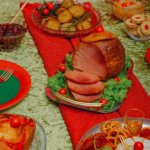Holiday Food Safety Tips
go.ncsu.edu/readext?970669
en Español / em Português
El inglés es el idioma de control de esta página. En la medida en que haya algún conflicto entre la traducción al inglés y la traducción, el inglés prevalece.
Al hacer clic en el enlace de traducción se activa un servicio de traducción gratuito para convertir la página al español. Al igual que con cualquier traducción por Internet, la conversión no es sensible al contexto y puede que no traduzca el texto en su significado original. NC State Extension no garantiza la exactitud del texto traducido. Por favor, tenga en cuenta que algunas aplicaciones y/o servicios pueden no funcionar como se espera cuando se traducen.
Português
Inglês é o idioma de controle desta página. Na medida que haja algum conflito entre o texto original em Inglês e a tradução, o Inglês prevalece.
Ao clicar no link de tradução, um serviço gratuito de tradução será ativado para converter a página para o Português. Como em qualquer tradução pela internet, a conversão não é sensivel ao contexto e pode não ocorrer a tradução para o significado orginal. O serviço de Extensão da Carolina do Norte (NC State Extension) não garante a exatidão do texto traduzido. Por favor, observe que algumas funções ou serviços podem não funcionar como esperado após a tradução.
English
English is the controlling language of this page. To the extent there is any conflict between the English text and the translation, English controls.
Clicking on the translation link activates a free translation service to convert the page to Spanish. As with any Internet translation, the conversion is not context-sensitive and may not translate the text to its original meaning. NC State Extension does not guarantee the accuracy of the translated text. Please note that some applications and/or services may not function as expected when translated.
Collapse ▲ Food, Friends and Family all go together during the holidays. Make sure this year you don’t add any unwanted guests when you are serving up the delicious holiday menu. Whether it’s a traditional dish or a new one you want to try, you still want to make sure that its prepared and served safely. Here are some tips to help you keep the holidays food safe so you are ready for a Healthy New Year!
Food, Friends and Family all go together during the holidays. Make sure this year you don’t add any unwanted guests when you are serving up the delicious holiday menu. Whether it’s a traditional dish or a new one you want to try, you still want to make sure that its prepared and served safely. Here are some tips to help you keep the holidays food safe so you are ready for a Healthy New Year!
Buffet Tips
- If you are planning buffet style meals, you want to make sure that you don’t have food out too long. Watch the clock, replace food that has been out for 2 hours.
- Keep it Fresh! Prepare multiple serving dishes to replace the ones that have been sitting for a while. Try not to just add new food to existing food platters and trays. This cuts down on possible bacteria that may have gotten on the foods as they were sitting out.
- Keep the Hot foods Hot – at or above 135ºF and Cold Foods Cold – at or below 40ºF
- Use a food thermometer that can measure cold and hot foods to make sure they are staying where they need to be.
- Store your back-up dishes in the refrigerator that need to keep cold and hot dishes in the oven set to 200ºF to 250ºF.
Reduce Risk from Un-cooked Foods
- Some of our traditional family recipes may call for raw or lightly cooked eggs. They may be Caesar salad dressings, eggnog, custard or other desserts, which if made the old way would increase our risk for Salmonella.
- Use pasteurized eggs in place of regular eggs to make these items safe.
- Cook ready-to-cook foods like cookie dough before eating. These types of items still have raw eggs and other ingredients and need to be cooked to ensure safety.
For more information on ways to make sure your dishes with eggs are safe and other holiday tips check out the FDA Holiday Tips. Also look for weekly tips on our Facebook and Twitter pages. You can always call our office if you have specific questions around keeping your holidays food safe.




